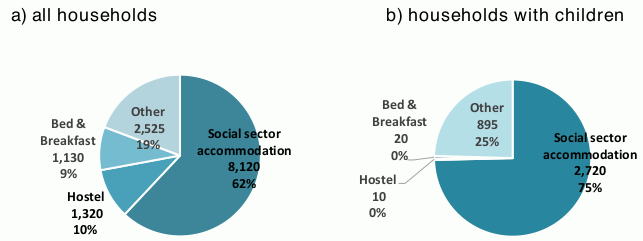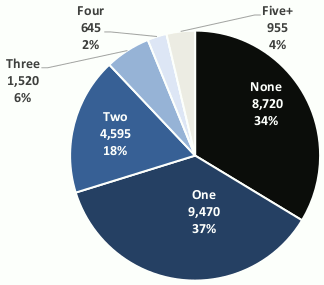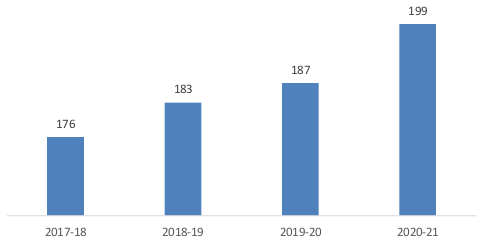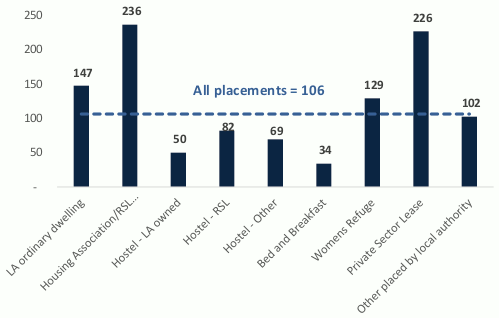Homelessness in Scotland: 2020 to 2021
This statistics bulletin provides information on homelessness in Scotland in the period from 1 April 2020 to 31 March 2021, alongside historical data.
This document is part of a collection
Temporary Accommodation
Key Points
- 62% of temporary accommodation used is in the social sector.
- 34% of homeless households had no temporary accommodation placement and 37% had one; 4% had 5 or more.
- Households spent 199 days in temporary accommodation on average.
- There were 605 cases of households not being offered temporary accommodation in 2020/21, an 87% fall compared to 2019/20.
- There were 490 breaches of the unsuitable accommodation order (to be treated with caution - see notes below)
Sources of temporary accommodation data
Since 2002, local authorities have provided aggregate snapshot information relating to households in temporary accommodation. While this allows trends to be explored over time, understanding around individual placements and how these relate to assessed households is not possible from the snapshot data. Therefore, since 1st April 2016 placement level information on households in temporary accommodation has been provided to enable a more rounded picture of the use of temporary accommodation.
The snapshot data shows 13,097 households in temporary accommodation as at 31st March 2021. The placement level returns show that there were 13,143 temporary accommodation placements open at 31st March 2021 – only very slightly higher (46, 0%) than the snapshot returns. Differences may be explained by the returns including different types of temporary accommodation and the placement level returns experiencing a lag in cases being closed.
Both of these figures show households in temporary accommodation at a point in time and, as such, will include those who have recently entered temporary accommodation as well as those who have been in temporary accommodation for a longer period of time (including prior to the reporting year).
Reporting of temporary accommodation
When considering certain aspects of temporary accommodation such as number of placements, average time spent in temporary accommodation etc., the true extent of this can only be fully understood once a household has exited temporary accommodation. A household is considered to have ‘exited’ temporary accommodation in a reporting year only if their homelessness case has closed.
How many people entered temporary accommodation? How many exited?
21,020 households entered a first temporary accommodation placement in 2020/21. To note, these will include households who made a homelessness application prior to 2020/21. 17,665 households exited their final temporary accommodation placement in 2020/21.
These figures give a net difference of 3,355 more households entering temporary accommodation than exiting. This ties in with the increase in the number of households in temporary accommodation which can be seen in the snapshot figures, although the numbers will not match given the differences outlined. (Table 33)
What types of temporary accommodation are used?

The above chart shows that social sector accommodation is the majority of temporary accommodation used, with a higher usage of these for households with children. Conversely, there are extremely low levels of use of hostels and bed & breakfast accommodation for households with children.
There was an increase in the use of bed and breakfast accommodation in 2020/21 compared to the previous year (7% to 9%) and a decrease in hostel accommodation (12% to 10%). Again, this is linked to the COVID-19 response with increased availability of bed & breakfast accommodation and additional funding being provided to local authorities to provide temporary accommodation in Edinburgh and Glasgow. Bed and breakfast accommodation was increasingly offered to households in this period as it was easier for households to socially distance in this accommodation type in comparison to other more communal accommodation such as hostels. (Tables 29).
Data from the placement level data collection can provide further insight in to the total use of temporary accommodation over the lifecycle of homelessness cases. However, it is difficult to make direct comparison with the snapshot data as different categories of temporary accommodation are used between the two returns.
There were 35,660 temporary accommodation placements taken up in 2020/21. 41% of temporary accommodation placements were in local authority ordinary dwellings or housing association/registered social landlord dwellings; 24% of placements were in hostel accommodation; and 24% of placements were in bed and breakfast accommodation. The higher proportions of hostel and bed and breakfast accommodation in the placement level returns (48% vs 19%) indicates that these types of temporary accommodation are more frequently used than the snapshot data suggests. However, this can be explained by the fact that the average duration for stays in these types of accommodation is much shorter - for example, 34 days in bed and breakfast compared to an average of 106 days for all temporary accommodation – and therefore they account for a much smaller proportion of the overall use of temporary accommodation. (Tables 39 & 40)
Data on the number of placements and average length of time will help improve understanding of the ways in which different types of temporary accommodation are used.
How many temporary accommodation placements do households typically have?

There is variation in the number of placements between local authorities. Only 6% of homeless households in Shetland (5 out of 80) did not have any temporary accommodation placements, compared to 70% (365 out of 520) in Scottish Borders, although caution should be applied for local authorities with small numbers of households. In Edinburgh, 25% (200 out of 815) of homeless households had 5 placements or more (Table 34).
How long do households spend in temporary accommodation?
For homelessness applications that closed in 2020/21, that had taken up temporary accommodation, they spent an average of 199 days in temporary accommodation. The increase from last year will be related to the fact more people are staying in temporary accommodation for longer in response to COVID-19. Note that total duration is calculated by summing the time a household spends in individual placements, excluding time between placements when a household is not in temporary accommodation. As a result the time a household spends in temporary accommodation may not be continuous.

Looking at average duration at a placement level shows duration varies by accommodation type with social sector temporary accommodation having higher durations than other types of accommodation. The average length of stay in housing association accommodation and local authority dwellings was 236 and 147 days respecitvely, compared to 34 days in bed & breakfast accommodation. This confirms the expected shorter-term use of bed & breakfast and hostel accommodation. (Table 40)

How often do applicants refuse temporary accommodation?
A household can choose to refuse an offer of temporary accommodation made by the local authority. In 2020/21 there were 7,102 cases of households refusing offers of temporary accommodation. This was an increase of 1,467 (26%) compared to 2019/20. There was a particulay high increase in Glasgow, which increased by 67% from 1,913 to 3,186. (Table 41) To note, a household that has refused an offer of temporary accommodation may accept a subsequent offer.
Information provided by local authorities suggest that the increase may be the result of households rejecting offers of bed and breakfast accommodation, which were more common as the availability of other accommodation types decreased during the pandemic while the availability of bed and breakfast accommodation increased.
How often do local authorities fail to provide temporary accommodation?
A local authority is required to indicate when they do not offer any temporary accommodation to a household and are therefore acting unlawfully. During 2020/21, there were 605[9] instances of households not being offered temporary accommodation (Table 40). The majority of these cases (525) were in Edinburgh. This compares with 4,590 cases in 2019/20, an 87% fall. This reflects the increased funding made available to local authoritiies alongside the increased availability of bed and breakfast accommodation during the COVID period. (Table 42)
How often do local authorities breach unsuitable accommodation legislation?
There were 490 breaches reported across 13 different local authorities in 2020/21. Fife accounted for 135 of these, East Lothian 125 and Renfrewshire 105, all having report no or very few breaches previously. Conversely, Edinburgh who do usually report a relatively high number of breaches reported less than 20. (Table 43)
Important! Over the reporting period i) there was a significant change to legislation and ii) temporary exceptions were put in place at very short notice in response to COVID-19, both of which have had considerable impacts on the data. The urgency of having to adapt to the revised legislation without any specific guidance means that local authorities have reported inconsistencies in the information captured regarding breaches which is likely to affect comparability. For these reasons, these figures should be treated with caution.
Changes in legislation
Prior to 5 May 2020, a breach was encountered when a household with a pregnant woman and/or child is in unsuitable temporary accommodation for more than 7 days. From 5 May 2020, this was extended to all households. Therefore, the total number of breaches across the year 2020/21 will include those based on both old and new legislation.
Covid-19 exceptions
Temporary exceptions were put in place to allow local authorities to provide households with accommodation in response to COVID-19. The legislation noted that a placement was not considered unsuitable if:
- a person in the household has symptoms of coronavirus and the household requires to isolate; or
- the accommodation is required to provide temporary accommodation to ensure that a distance of 2 metres can be maintained between a member of the household and a person who is not a member of the household in order to prevent the spread of coronavirus; or
- the local authority is unable to place the household in suitable accommodation as a result of the impacts of coronavirus on temporary accommodation supply in the area, provided that where a household includes a child or a pregnant woman the household is not placed in unsuitable accommodation for more than 7 days.
(To note: the third of these only came into effect on 30th September, halfway through the reporting period covered by this publication.)
A household placed in unsuitable accommodation for longer than 7 days where an exception did not apply must still be recorded as a breach.
Contact
There is a problem
Thanks for your feedback